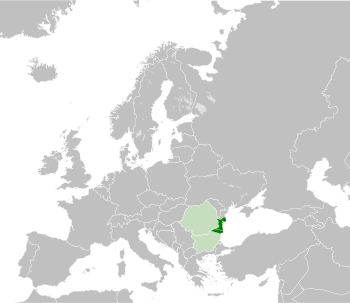
Back Dobrucha AN دبروجة Arabic Дабруджа Byelorussian Дабруджа BE-X-OLD Добруджа Bulgarian Dobrudja Catalan Dobruca CRH Dobrudža Czech Dobrogea Danish Dobrudscha German


Dobruja or Dobrudja (US: /ˈdoʊbrʊdʒə/;[1] Bulgarian: Добруджа, romanized: Dobrudzha or Dobrudža; Romanian: Dobrogea, pronounced [ˈdobrodʒe̯a] ⓘ or [doˈbrodʒe̯a]; Ukrainian: Задунав'я, romanized: Zadunav"ya; Turkish: Dobruca; Dobrujan Tatar: Tomrîğa) is a geographical and historical region in Southeastern Europe that has been divided since the 19th century between the territories of Bulgaria and Romania. It is situated between the lower Danube River and the Black Sea, and includes the Danube Delta, the Romanian coast, and the northernmost part of the Bulgarian coast. The territory of Dobruja is made up of Northern Dobruja, which is a part of Romania, and Southern Dobruja, which is a part of Bulgaria.
The territory of the Romanian region Dobrogea is organised as the counties of Constanța and Tulcea, with a combined area of 15,588 km2 (6,019 sq mi) and, as of 2021[update], a population of slightly less than 850,000. Its main cities are Constanța, Tulcea, Medgidia, and Mangalia. Dobrogea is represented by dolphins in the coat of arms of Romania.
The Bulgarian region Dobrudzha is divided among the provinces of Dobrich and Silistra; the following villages of Razgrad Province: Konevo, Rainino, Terter and Madrevo; and the village General Kantardzhievo (Varna). The region has a total area of 7,566 km2 (2,921 sq mi), with a combined population as of 2021[update] of some 250,000 people. The main towns are Dobrich and Silistra, the administrative centers of the two provinces.
- ^ "Dobruja". Collins English Dictionary. HarperCollins. Retrieved 21 July 2019.